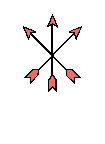 THE JESTER has no move of its own but mimics the move of the
last opponent piece played. The Jester is subject to two constraints:
THE JESTER has no move of its own but mimics the move of the
last opponent piece played. The Jester is subject to two constraints:
by Thomas Havel
Jester Chess is a unique game in that it emphasizes the fun aspect of chess variants. Its jocular mood is achieved through the use of a new piece called the Jester. Each game is bound to cause some smiles, laughs and howls, along with the usual vexations that all chess enthusiasts enjoy. While there was no attempt to incorporate the element of chance into the game, situations may arise which seem to border on chaos.
Jester Chess uses the six familiar FIDE Chess pieces, plus four new pieces, which are described below:
 THE JESTER has no move of its own but mimics the move of the
last opponent piece played. The Jester is subject to two constraints:
THE JESTER has no move of its own but mimics the move of the
last opponent piece played. The Jester is subject to two constraints:
The Jester was inspired by T. R. Dawsons Imitating Joker.
 THE STEWARD is a quadra-pawn. It moves as a Pawn in all four directions.
The icon for the Steward is four small Pawns facing the four orthogonal directions.
In play, two Stewards linked in mutual coverage make a formidable barrier to an
up-the-center attack.
THE STEWARD is a quadra-pawn. It moves as a Pawn in all four directions.
The icon for the Steward is four small Pawns facing the four orthogonal directions.
In play, two Stewards linked in mutual coverage make a formidable barrier to an
up-the-center attack.
 THE MURRAY LION was created inadvertently when chess historian
H. J. R. Murray erred in describing the Chu Shogi lion in
The History of Chess.
However,
Murrays piece is in many ways more playable than its
Chu Shogi
Counterpart.
The Murray Lion may leap to the second square either orthogonally or diagonally --
or it may move only to capture as a King.
THE MURRAY LION was created inadvertently when chess historian
H. J. R. Murray erred in describing the Chu Shogi lion in
The History of Chess.
However,
Murrays piece is in many ways more playable than its
Chu Shogi
Counterpart.
The Murray Lion may leap to the second square either orthogonally or diagonally --
or it may move only to capture as a King.
 THE ARCHER is unique in that it always moves without capturing and always
captures without moving. Its move description reads as follows:
THE ARCHER is unique in that it always moves without capturing and always
captures without moving. Its move description reads as follows:
The Archer may seem gratuitously complex, yet its move was finalized only after years of play testing. Given any more power, it tends to dominate the game.

Click here for cutout piece patterns.
Click here to download Jester Chess for Zillions of Games. (Not yet available)
The rules for Jester are the same as for FIDE Chess, except for the following changes:
The following schedule of promotions will apply to pieces arriving at the 9th rank. Pieces not listed here do not promote.

 Pawns promote to STEWARDS. The steward is a quadra-pawn that may move
and capture as a Pawn in all four directions.
The Steward
is described earlier in this document.
Pawns promote to STEWARDS. The steward is a quadra-pawn that may move
and capture as a Pawn in all four directions.
The Steward
is described earlier in this document.

 Knights promote to MARCHING KNIGHTS. The Marching Knight may leap as a
Knight or move one square orthogonally -- with or without capturing.
Knights promote to MARCHING KNIGHTS. The Marching Knight may leap as a
Knight or move one square orthogonally -- with or without capturing.
Murray Lions


 Bishops promote to ARCHBISHOPS. The Archbishop may move as a Bishop
or move one square orthogonally -- with or without capturing.
Bishops promote to ARCHBISHOPS. The Archbishop may move as a Bishop
or move one square orthogonally -- with or without capturing.

 Rooks promote to ARCHROOKS. The Archrook may move as a Rook or
move one square diagonally -- with or without capturing.
Rooks promote to ARCHROOKS. The Archrook may move as a Rook or
move one square diagonally -- with or without capturing.
Piece Values
(adjusted for a 10x11 board)
|
Pawn |
= 0.6 |
Queen |
= 9.1 |
|
Steward |
= 0.9 |
King |
= 2.0 (valued as a fighting piece) |
|
Knight |
= 2.7 |
Jester |
= 3.? (see Playing Tips below ) |
|
Archer |
= 2.8 |
Marching Knight |
= 3.6 |
|
Bishop |
= 3.4 |
Archbishop |
= 4.6 |
|
Lion |
= 4.7 |
Regal Lion |
= 5.4 |
|
Rook |
= 5.5 |
Archrook |
= 6.5 |
In Jester Chess, you should go all out to protect your home turf from opponent
promotions.
For when an opponent piece
promotes, it usually inflicts a number of casualties. This breach in defense
enables other promotions, thereby feeding a vicious circle. Consequently, the
first player to promote a major piece is likely to control the game. The irony
here is that the more effort one commits to winning promotions, the less capable
he will be of protecting his own territory. Another Irony is that the more
promoted pieces that you have, the more power will be conveyed to your opponent's Jesters.
Archers Jesters
Due to the Jester's mercurial properties, it is almost impossible to assign it a value. Remember that the piece often ranks as low as a pawn and sometimes as high as a Queen. Yet most experienced players will exchange a Jester for a Bishop or an Archer, if it will win them a good position.
Q: Why does the Jester have restrictions on its ability to imitate? Would not a Jester with full imitation powers be simpler to play with?
A: Originally, the Jester had no such restrictions and tended to dominate game. It was weakened in order to achieve a more balanced game.
Q: If the opponent piece were a Queen which made a diagonal non-capturing move, would the Jester be limited to making a diagonal non-capturing move?
A: No. The Jester would be allowed to make any non-capturing that a Queen could make.
Q: If the opponent piece were a Queen which made a diagonal capturing move, would the Jester be limited to making a diagonal capturing move?
A: No. The Jester would be allowed to make any capturing or non-capturing move that a Queen could make.
Q: If you make a capturing move with your Queen, and your opponent's Jester subsequently makes a non-capturing move (as a Queen), which move would your Jester inherit? -- the full Queen move or the limited Jester move?
A: The limited Jester move. Since the first Jester did not capture, the second Jester may not capture.
Q: If a piece promotes on its move, does the Jester imitate the original piece or the promoted piece?
A: The promoted piece.
Q: If I have a Rook that is "pinned" by an opponent Jester (as in the following diagram), can I move my Rook out of file b, if I make the move without capturing?
+---+---+---+---+ | | K | | | +---+---+---+---+ | | R | | | +---+---+---+---+ | | | | | +---+---+---+---+ | | J | | | +---+---+---+---+ a b c d
A: Yes. But your Rook may not move out of file b plus make a capture, as this would enable the opponent Jester to check your King.
Q: Why is the Steward shown worth only 1-1/2 Pawns, in the Piece Values section? This seems counterintuitive.
A: Two Reasons: (1) The Steward does not promote whereas the Pawn does. (2) The Steward is valued as an individual piece. A Steward pair, linked in mutual coverage, would be valued at about two Pawns a piece.
Tom Havels e-mail address is (email removed contact us for address) o.com